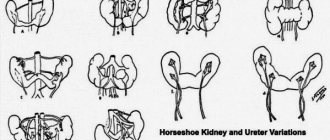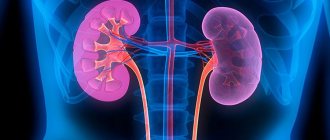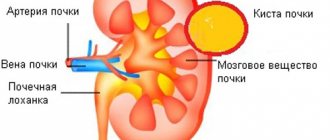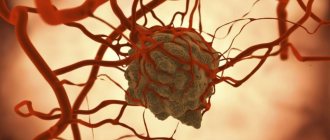The kidney is an organ in which the blood is filtered and the fluid that is unnecessary for a person is released - urine. A person has two of them and they are located behind the abdominal organs on either side of the spine.
The treatment regimen for kidney cancer depends on the type of tumor. Most often, the disease affects the cells lining the kidney tubules (microtubules that filter blood). This type of tumor is called renal cell tumor.
Much less common are foci of tumor growth in the renal pelvis and ureters. The renal pelvis is a cavity that collects urine. After they are filled, urine enters the ureter, a tube that connects the organ to the bladder. This principle of operation leads to the fact that the cells of the inner lining of the pelvis and ureter can change their size (stretch and contract). Therefore, they are called transitional epithelium, and this form is called transitional cell carcinoma.
The disease sometimes occurs in young children. Such neoplasms are called nephroblastomas or Wilms tumors.
Causes and risk factors
The main risk factors for developing the disease include:
- genetic predisposition (Hippel-Lindau disease, etc.);
- elderly age;
- smoking;
- obesity;
- high blood pressure (hypertension);
- the use of long-term dialysis in the treatment of chronic renal failure;
- abuse of painkillers (phenacetin, aspirin, ibuprofen, etc.), some other drugs (cyclophosphamide);
- contact with carcinogens at work (industrial dyes, rubber, plastic, aluminum, pesticides, etc.).
Stages of kidney cancer
1 tbsp.
The size of the neoplasm is up to 7 mm and does not extend beyond the organ. The prognosis is positive, most patients go into stable remission.
2 tbsp.
The size of the lesion is more than 7 mm, but the lymph nodes are also not affected. The prognosis is favorable.
3 tbsp.
The tumor is additionally detected in at least one lymph node. At this stage, the disease can affect large blood vessels inside and outside the organ and spread to the surrounding fatty tissue. The prognosis depends on the type of cancer and the degree of damage to the lymphatic system and is done individually.
4 tbsp.
The disease spreads beyond the fatty tissue, multiple lesions of the lymph nodes are noted, metastases are found in the adrenal glands, intestines, pancreas, liver, lungs, and bones. Despite the unfavorable prognosis, in some cases it is possible to achieve stable remission. There is always a chance for recovery.
Metastatic kidney cancer
Metastatic cancer is a malignant tumor that spreads to other organs and tissues through metastases.
Kidney cancer most often metastasizes to the lungs, but can also spread to the lymph nodes, bones, liver, brain, skin and other areas of the body. This is a systemic disease that requires systemic therapy - targeted or immunotherapy. Sometimes, in the presence of metastases, the tumor-affected kidney is removed (cytoreductive nephrectomy). This surgery prevents pain and bleeding during systemic treatment. If kidney cancer has spread to one organ (for example, a single metastasis in the lung), surgical removal of the lesion (metastasectomy) may be performed. This operation helps to increase life expectancy in some patients. If the cancer has spread to many organs or tissues outside the kidney, it is more difficult to treat. Surgery does not help in this case; instead, systemic therapy is performed.
The most effective treatments for metastatic kidney cancer today are combinations of immune drugs that activate the immune system to destroy cancer cells. They prolong life compared to standard treatment. Palliative medicine is also important to relieve symptoms and side effects.
Treatment methods for kidney cancer
The main method of treatment is 1-2 tbsp. - operation. Its features are determined by the type of neoplasm and the patient’s condition.
Classic surgery with direct access:
Partial nephrectomy
– kidney resection for stage 1 cancer, during which the cancerous tumor is excised along with part of the surrounding tissue. It is performed for patients with small formations (less than 4 cm) or for those patients for whom complete removal is not indicated.
Complete nephrectomy
, in which the entire organ is removed.
Nephroureectomy
– surgery to remove a kidney with a tumor along with the ureter, sometimes with part of the bladder and lymph nodes (the main method for transitional cell type cancer).
Segmental urethrectomy
, in which part of the ureter with a cancerous tumor is removed. This method is chosen when the lesion is small and located closer to the bladder. Depending on the method of classical intervention, the surgeon makes 2 large incisions: on the stomach and on the back, on the side and on the back, on the chest and on the abdomen.
Laparoscopy (limited access surgery).
It is carried out using a laparoscope. This involves making several small incisions, which reduces the risk of infection and speeds up healing.
Endoscopic surgery.
An organ-sparing procedure to remove a small mass in the kidney or ureter using an endoscope, which is inserted into the body through a small incision under anesthesia. The operation is performed under ultrasound or CT guidance. Kidney resection using this method is rarely performed and is performed exclusively for stage 1 cancer due to the high risk of the disease returning.
Sometimes chemotherapy or radiation therapy is required after surgery.
Kidney cancer: symptoms
For a long period, the oncological process occurs in a latent form, without making itself felt. The first symptoms may appear only after 3-5 years, and in 30% of cases the tumor process is diagnosed due to symptoms arising from the fact that distant organs are affected by metastases.
Clinical signs can be divided into two main groups: urological and non-urological. The second ones appear:
- reduced tolerance to physical activity;
- increased sweating;
- rise in body temperature, mainly in the evening;
- severe swelling of the legs;
- unmotivated high blood pressure associated with an increase in the level of angiotensin (this substance is intensively produced due to weakened blood circulation in the kidney tissue, since it is partially taken away by the kidney tumor).
With the progression of the disease, paraneoplastic syndrome comes to the fore - a complex of clinical and laboratory symptoms that indirectly indicate the presence of an oncological process. These include:
- increased duration of erythrocyte sedimentation rate in the CBC;
- prolonged and constant high temperature;
- increased number of red blood cells;
- increased levels of calcium in the blood;
- non-metastatic hepatomegaly.
Urological signs are manifested by three classic symptoms:
- Hematuria - blood in the urine. Kidney cancer is characterized by its manifestation against the background of complete well-being; discharge in the form of worm-like clots (in the shape of the ureters) is often observed. Hematuria can be very varied in intensity and duration, often stops on its own, and can recur without treatment of the underlying pathology.
- Painful sensations in the area of the projection of the kidneys. Observed in half of the patients, they are characterized by a feeling of heaviness and discomfort in the lumbar region. Due to blockage of the ureter by a blood clot, the phenomenon of renal colic may occur.
- In 20% of patients, it is possible to palpate a humpbacked and dense neoplasm - the so-called tumor-like kidney.
Urological symptoms of kidney cancer, as a rule, are delayed, and in about a third of patients, metastases are detected in the presence of these signs.
Radical methods of treating kidney cancer without surgery:
- Radiosurgical method. Bloodless remote destruction of a tumor using a robotic CyberKnife installation. The death of cancer cells occurs under the influence of high doses of radiation. The exceptional accuracy of the method allows us to minimize the effect of radiation on healthy tissue. The result of CyberKnife therapy is comparable to the result of conventional surgery or removal of a kidney tumor using minimally invasive methods (laparoscopy, endoscopic surgery). Moreover, during the procedure the patient does not experience any inconvenience, does not require anesthesia and can be discharged home immediately after treatment. The only limitation to using the method is the size of the lesion is larger than 6 cm.
- Laser destruction. Another method of radical therapy in the early stages. Rarely used due to the high risk of relapse.
- Destruction by freezing (cryoablation) or heating (radiofrequency ablation). When using these methods, nitrous oxide or high-frequency currents are supplied to the tumor through special needles. The procedures are performed under local anesthesia and X-ray control. Rarely used due to the likelihood of the disease returning.
At stage 3, complex therapy is carried out using various methods:
- surgery and chemotherapy;
- surgery, chemotherapy and radiation therapy.
Before surgery, the blood supply to the tumor may be blocked to reduce its size.
Chemotherapy for kidney cancer usually includes a combination of medications:
- GC – gemcitabine and cisplatin.
- GemCarbo – gemcitabine and carboplatin.
- MVAC – Methotrexate, vinblastine, doxorubicin and cisplatin.
In rare cases, chemotherapy is given through a tube directly into the ureter (regional chemotherapy). This method can be chosen as an alternative to surgery.
In parallel with chemotherapy, when treating patients with kidney cancer at this stage, immunotherapy (interleukin-2 or interferon-Alpha) and/or targeted therapy (sorafenib (Nexavar), sunitinib (Sutent), temsirolimus (Torisel), everolimus (Afinitor) may be prescribed. , bevacizumab (Avastin), pazopanib (Votrient), or axitinib (Inlyta)).
The choice of a set of treatment methods at stage 4 is determined depending on the patient’s condition, the nature and extent of the problems.
Surgical methods of treatment
Surgical treatment involves removing the tumor and some surrounding healthy tissue during surgery. If the cancer has not spread beyond the kidneys, the only treatment needed may be surgery to remove the tumor, part or all of the kidney, and possibly nearby tissue and lymph nodes.
Types of surgeries for kidney cancer
Radical nephrectomy. Usually performed when treating a large tumor, when there is little healthy kidney tissue left: the tumor, the affected organ and surrounding tissue are removed. If the disease affects nearby tissues and surrounding lymph nodes, radical nephrectomy and lymph node removal are performed. If the cancer has spread to the adrenal gland or nearby blood vessels, the surgeon may remove the adrenal gland (adrenalectomy) and parts of the blood vessels. Sometimes a kidney tumor grows directly inside the renal vein, and on the way to the heart, the tumor thrombus can grow into the vena cava. In this case, complex cardiovascular surgical interventions are necessary to safely remove all tumor changes.
Partial nephrectomy. Surgical removal of the tumor and part of healthy kidney tissue. This type of surgery preserves kidney function and reduces the risk of developing chronic kidney disease after surgery. Studies have shown that partial nephrectomy is effective for T1 tumors in all cases where surgery is possible.
Laparoscopic and robotic surgery (minimally invasive surgery). During laparoscopic surgery, organs are accessed through several small punctures in the abdominal wall. Through these punctures, the surgeon inserts laparoscopic instruments to completely remove the kidney or perform a partial nephrectomy. Sometimes the surgeon may use robotic instruments during surgery. Robotic surgery may take longer but is less traumatic. Laparoscopic and robotic approaches require special training. It is important to discuss the potential benefits and risks of such procedures with your surgeon in advance and to be sure that the surgical team has experience in performing them.
Consequences of therapy
The consequences of surgery include the risk of complications such as a reaction to anesthesia, pain in the operated area, bleeding, and infection.
Chills, fever, nausea, vomiting and loss of appetite may occur during chemotherapy treatment.
Side effects of targeted therapy include the possibility of rash, diarrhea and fatigue.
During radiotherapy, weakness, fatigue, and redness of the skin may occur.
Modern methods of treatment
Since cancer cells in malignant kidney disease are insensitive to chemotherapy and radiation therapy, these methods are practically not used. However, today there are techniques that can be used to successfully fight kidney cancer even in an advanced stage. We are talking about immunotherapy and the use of targeted drugs.
- When carrying out targeted therapy, the action of drugs is aimed at certain molecules that are vital for malignant cells; blocking them suppresses the growth of new vessels, important for feeding the tumor, and the formation of proteins that stimulate cancer cell division.
- Immunotherapy drugs affect the human immune system, which destroys cancer cells. There are different types of immunotherapy: adaptive T-cell therapy, checkpoint inhibitors, vaccines. Each of the drugs has its own advantages, and, unlike standard chemotherapy, side effects occur less frequently. With a good response to treatment, it is possible to prevent metastasis; in patients with an inoperable tumor, further progression of the disease stops. However, the drugs must be prescribed by a specialist, since if they are used incorrectly, they can have the opposite effect.
To verify the body’s sensitivity to drugs and select the most effective remedy, a molecular genetic study is necessary - an effective high-tech examination available to our patients.
Recovery after treatment
After discharge from the hospital, you will be under the supervision of doctors. In the first year, examinations and examinations are usually carried out every 3 months, in the second and third - every 6 months. After this - annually. During the recovery process, it is very important to eat properly and follow the regimen recommended by your doctor.
If you need a second opinion to clarify your diagnosis or treatment plan, send us an application and documents for consultation, or schedule an in-person consultation by phone.
+7 499 490-24-13
Expert opinion
Observation after treatment
Monitoring of patients with cancer continues after completion of active treatment. This may include regular physical examinations and medical tests, including to rule out recurrence.
Recommendations for monitoring a patient depend on several factors, including the type and stage of cancer and the type of treatment received. Patients who have undergone surgery for kidney cancer often need to have their kidney function monitored for the rest of their lives.
The team of doctors at the oncology department of the Rassvet Clinic continues to monitor the patient after treatment. We not only screen for relapse, but also help manage side effects and monitor your overall health.









